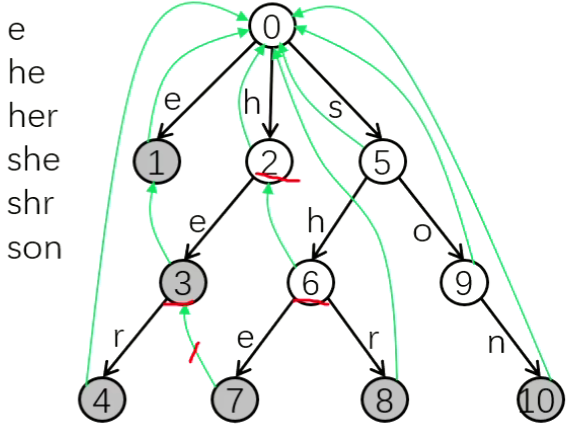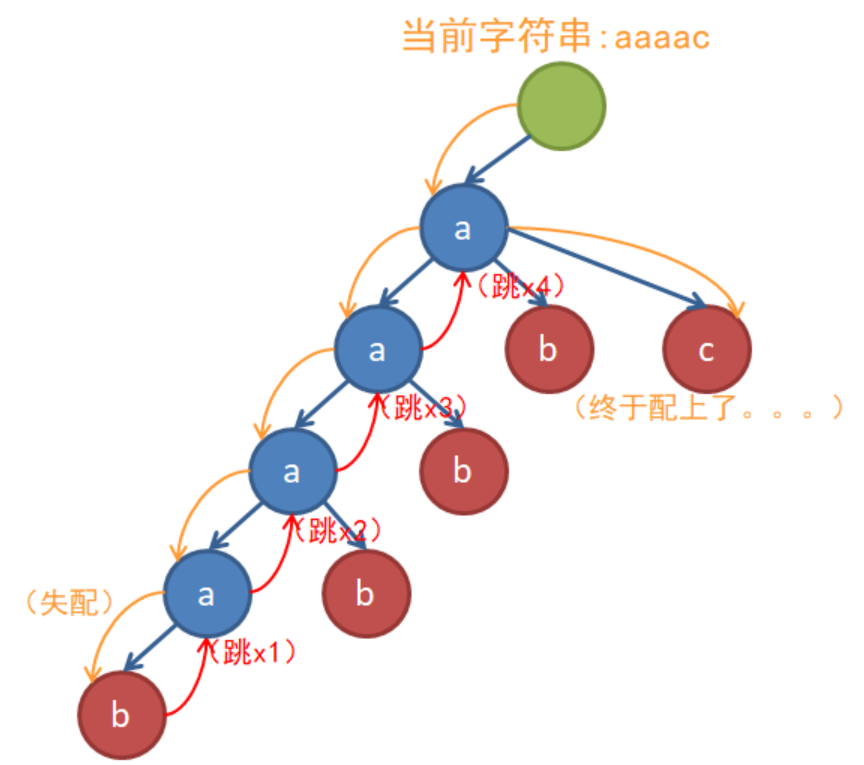AC自动机
听说不难学?
给定 n 个模式串和一个主串,查找有多少个模式串在主串中出现过
- 构造 trie 树,如果节点是模式串,cnt[u]++
- 构造自动机,即建边
回跳边指向父节点的回跳边所指向节点的儿子,例如:7 号点的回跳边是 3 号点

回跳边所指节点是当前节点的最长后缀,例如,7 号点是 she,最长后缀是 he
转移边指向当前节点的回跳边所指节点的儿子,例如 ch[7][r] 就是 4,意义是:转移边所指节点是当前节点的最短路(he)
bfs 建边:
- 若儿子存在,则父亲帮儿子建立回跳边
- 不存在,父亲自建转移边
查找:
- i 指针沿着树边或者转移边走,不回退
- j 指针沿着回跳边搜索,把当前节点的所有后缀模式串一网打尽
c++
void build() {
queue<int> q;
for (int i = 0; i < 26; i++) {
if (tr[0][i]) {
q.push(tr[0][i]);
}
}
while (q.size()) {
int u = q.front();
q.pop();
for (int i = 0; i < 26; i++) {
if (tr[u][i]) {
ne[tr[u][i]] = tr[ne[u]][i];
q.push(tr[u][i]);
} else {
tr[u][i] = tr[ne[u]][i];
}
}
}
}
int query(char *s) {
int u = 0, res = 0;
for (int i = 1; s[i]; i++) {
u = tr[u][s[i] - 'a'];
for (int j = u; j && cnt[j] != -1; j = ne[j]) {
res += cnt[j];
cnt[j] = -1; // 这里是统计出现过,所以匹配到了就清空
}
}
return res;
}基本代码是上面的,当然存在很多变式和优化
看下面的图,发现沿着 fail 边跳了很多次,如果一步到位找到儿子有 c 的节点就好了,不如直接把 c 那个节点作为自己的儿子

然后,加入一个 lst 数组,表示在它顶上的fail边所指向的一串节点中,第一个真正的结束节点,就可以跳过中间那些不是字符串结束位置的点了,每次计数时改为跳 lst 边
代码示例如下:100350. 最小代价构造字符串
c++
const int N = 5e4 + 10;
const int inf = 0x3f3f3f3f;
int sz, ch[N][26], val[N], f[N], lst[N], dep[N];
int dp[N];
void getfail(){
queue<int> Q;
f[0] = 0;
for(int i=0; i<26; ++i){
int u = ch[0][i];
if(u){
f[u] = 0;
lst[u] = 0;
Q.push(u);
}
}
while(!Q.empty()){
int r = Q.front(); Q.pop();
for(int c=0; c<26; ++c){
int u = ch[r][c];
if(!u){
ch[r][c] = ch[f[r]][c];
continue;
}
Q.push(u);
int v = f[r];
while(v && !ch[v][c]) v = f[v];
f[u] = ch[v][c];
lst[u] = val[f[u]] == inf ? lst[f[u]] : f[u];
}
}
}
void update(int u, int i){
if(u){
dp[i] = min(dp[i], dp[i - dep[u]] + val[u]);
update(lst[u], i);
}
}
class Solution {
public:
int minimumCost(string target, vector<string>& words, vector<int>& costs) {
// 初始化及插入
sz = 0;
memset(ch[0], 0, sizeof(ch[0]));
val[0] = 0;
dep[0] = 0;
for(int i=0; i<words.size(); ++i){
string &s = words[i];
int u = 0, c = 0;
for(char v : s){
c = v - 'a';
if(!ch[u][c]){
ch[u][c] = ++sz;
memset(ch[sz], 0, sizeof(ch[sz]));
val[sz] = inf;
dep[sz] = dep[u] + 1;
}
u = ch[u][c];
}
val[u] = min(val[u], costs[i]);
}
getfail();
// 本题的 dp
int len = target.length();
dp[0] = 0;
int u = 0, c = 0;
for(int i=1; i<=len; ++i){
dp[i] = inf;
c = target[i-1] - 'a';
u = ch[u][c];
update(u, i);
}
if(dp[len] == inf) return -1;
return dp[len];
}
};灵神模板
c++
struct Node {
Node* son[26]{};
Node* fail; // 当 o.son[i] 不能匹配 target 中的某个字符时,o.fail.son[i] 即为下一个待匹配节点(等于 root 则表示没有匹配)
Node* last; // 后缀链接(suffix link),用来快速跳到一定是某个 words[k] 的最后一个字母的节点(等于 root 则表示没有)
int len; // 从根到 node 的字符串的长度,也是 node 在 trie 中的深度
int cost = INT_MAX;
Node(int len) : len(len) {}
};
struct AhoCorasick {
Node* root = new Node(0);
void put(string& s, int cost) {
auto cur = root;
for (char b : s) {
b -= 'a';
if (cur->son[b] == nullptr) {
cur->son[b] = new Node(cur->len + 1);
}
cur = cur->son[b];
}
cur->cost = min(cur->cost, cost);
}
void build_fail() {
root->fail = root->last = root;
queue<Node*> q;
for (auto& son : root->son) {
if (son == nullptr) {
son = root;
} else {
son->fail = son->last = root; // 第一层的失配指针,都指向根节点 ∅
q.push(son);
}
}
// BFS
while (!q.empty()) {
auto cur = q.front();
q.pop();
for (int i = 0; i < 26; i++) {
auto& son = cur->son[i];
if (son == nullptr) {
// 虚拟子节点 o.son[i],和 o.fail.son[i] 是同一个
// 方便失配时直接跳到下一个可能匹配的位置(但不一定是某个 words[k] 的最后一个字母)
son = cur->fail->son[i];
continue;
}
son->fail = cur->fail->son[i]; // 计算失配位置
// 沿着 last 往上走,可以直接跳到一定是某个 words[k] 的最后一个字母的节点(如果跳到 root 表示没有匹配)
son->last = son->fail->len ? son->fail : son->fail->last;
q.push(son);
}
}
}
};TsReaper 模板
cpp
// AC 自动机模板开始
const int MAXTOT = 1e5;
struct AhoCorasick {
int tot, ch[MAXTOT + 10][26], dep[MAXTOT + 10], fail[MAXTOT + 10];
int newNode(int d) {
int ret = tot++;
memset(ch[ret], 0, sizeof(ch[ret]));
dep[ret] = d;
fail[ret] = 0;
return ret;
}
void reset() {
tot = 0;
newNode(0);
}
AhoCorasick() { reset(); }
void insert(const char *s) {
int now = 0;
for (int i = 0; s[i]; s++) {
int c = s[i] - 'a';
if (ch[now][c] == 0) ch[now][c] = newNode(dep[now] + 1);
now = ch[now][c];
}
}
void buildFail(const char *s) {
queue<int> q;
for (int c = 0; c < 26; c++) if (ch[0][c] > 0) q.push(ch[0][c]);
while (!q.empty()) {
int sn = q.front(); q.pop();
for (int c = 0; c < 26; c++) {
int x = ch[sn][c], y = ch[fail[sn]][c];
if (x > 0) {
fail[x] = y;
q.push(x);
} else {
ch[sn][c] = y;
}
}
}
}
} ac;
// AC 自动机模板结束
class Solution {
public:
int minValidStrings(vector<string>& words, string target) {
// 用 words 里的字符串构建 AC 自动机
ac.reset();
for (int i = 0; i < words.size(); i++) ac.insert(words[i].c_str());
ac.buildFail(target.c_str());
int n = target.size();
long long f[n + 1];
f[0] = 0;
// 将 target 输入 AC 自动机,now 是 target 的第 i 个字符匹配的节点
for (int i = 1, now = 0; i <= n; i++) {
int c = target[i - 1] - 'a';
now = ac.ch[now][c];
// AC 自动机上匹配失败,返回无解
if (now == 0) return -1;
// 最后一次加上的前缀长度,就是当前节点的深度
f[i] = f[i - ac.dep[now]] + 1;
}
return f[n];
}
};fail 指针的含义是:i 的 fail 指向 j,表示根到 j 的串是根到 i 的串的后缀
